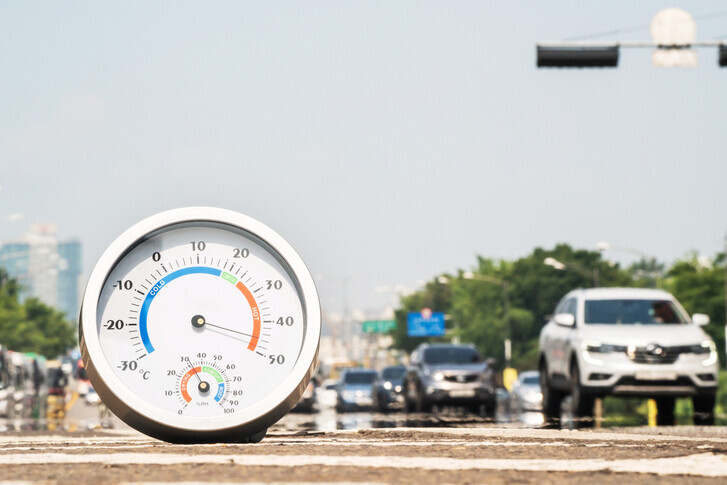hankyoreh
Links to other country sites 다른 나라 사이트 링크
Hot weather hat trick to send the mercury soaring in Korea

The untimely heat wave that’s swallowed up the Northern Hemisphere has set temperatures rising across the world. Global warming is causing temperatures in the Arctic to rise, resulting in the blocking of air currents that create a “heat dome” of trapped warm air. As the El Nino climate pattern subsides and we approach solar maximum, a brutally hot summer is in our forecast.
On June 10, a heat wave advisory was issued for the city of Daegu, in southeastern Korea, signaling an unprecedentedly early rise in temperature. But the June heat wave, it seems, is only the beginning.
Temperatures in Southeast Asia have already exceeded 40 degrees Celsius (104 F) for the past two months. Countries like Vietnam and the Philippines have even canceled school for children in the face of such sweltering heat. Temperatures in Saudi Arabia have recently climbed as high as 51.8 C, resulting in hundreds of people dying during religious pilgrimages to Mecca. In the United States, the sweltering summer heat has expanded beyond the usual regions in the South to hit people on the East Coast, where authorities have issued heat wave advisories amid temperatures exceeding 32 C (89.6 F).
A Reuters report on Wednesday said that the heat wave that has been swallowing Asia since April is impossible to explain without citing human-induced global warming. The article cited scientists who claimed that the current heat wave arrived much earlier than historical averages suggest.
Meteorological experts are referring to a “heat dome” of trapped warm air that is causing temperatures in the Northern Hemisphere to rise up to the 40s and 50s. A heat dome occurs when a prolonged period of high atmospheric pressure acts as a sort of lid that traps heat, resulting in a sort of greenhouse effect.
“Normally, in the Northern Hemisphere, the cold air from the Arctic and the warm air from the south need to blend, but as temperatures in the Arctic continue to rise, the reduced disparity between northern and southern currents is leading to a sort of stagnation of currents,” said Kim Hae-dong, a professor of global environmental science at Keimyung University.
This stagnation of currents leads to the “blocking” phenomenon, where high atmospheric pressure leads to a heat dome of trapped warm air.
As the El Nino weather pattern of last year subsides, we are approaching solar maximum, a prolonged period of solar activity marked by increased sunspot activity. This is also contributing to heat waves arriving early.
“The year after El Nino normally seems heat waves, and the solar maximum [which occurs every 11 years] is a period of increased sunspot activity that elevates the intensity of sunlight, making global temperature rises unavoidable,” said Kim Baek-min, a professor of environmental atmospheric sciences at Pukyong National University.
“This is why people are talking about this year as one that is likely to see record temperatures.”

The heat wave that is currently hitting Korea is a temporary phenomenon caused by a migratory anticyclone. However, as the monsoon season ends, the North Pacific High will expand, making it likely that the heat dome will grow to swallow other Northern Hemisphere countries, including Korea. Clear skies offer no cloud resistance to the increased intensity of sunlight, resulting in a “dry sauna” effect that’s expected to continue. Once monsoon season arrives, this intense heat will mix with the humidity brought by the North Pacific High anticyclone, resulting in a “wet sauna.”
As there are many variables in weather patterns, it’s too early to say for sure, but there is a high chance of South Korea experiencing its longest heat wave since 2018 (31 days).
By Shin So-yoon, staff reporter
Please direct questions or comments to [english@hani.co.kr]

Editorial・opinion
![[Editorial] Exploiting foreign domestic workers won’t solve Korea’s birth rate problem [Editorial] Exploiting foreign domestic workers won’t solve Korea’s birth rate problem](https://flexible.img.hani.co.kr/flexible/normal/500/300/imgdb/original/2024/0626/5517193887628759.jpg) [Editorial] Exploiting foreign domestic workers won’t solve Korea’s birth rate problem
[Editorial] Exploiting foreign domestic workers won’t solve Korea’s birth rate problem![[Column] Kim and Putin’s new world order [Column] Kim and Putin’s new world order](https://flexible.img.hani.co.kr/flexible/normal/500/300/imgdb/original/2024/0625/9617193034806503.jpg) [Column] Kim and Putin’s new world order
[Column] Kim and Putin’s new world order- [Editorial] Workplace hazards can be prevented — why weren’t they this time?
- [Editorial] Seoul failed to use diplomacy with Moscow — now it’s resorting to threats
- [Column] Balloons, drones, wiretapping… Yongsan’s got it all!
- [Editorial] It’s time for us all to rethink our approach to North Korea
- [Column] Why empty gestures matter more than ever
- [Editorial] Seoul’s part in N. Korea, Russia upgrading ties to a ‘strategic partnership’
- [Column] The tragedy of Korea’s perpetually self-sabotaging diplomacy with Japan
- [Column] Moon Jae-in’s defense doublethink
Most viewed articles
- 1Nuclear South Korea back up for debate as North cozies up to Russia
- 2‘Disposable’: How illegal temp work practices push migrants in Korea into risky jobs
- 3After 7 years, South Korea resumes live-fire drills on islands a stone’s throw from North
- 4[Reportage] On Yeonpyeong Island, residents fear military drills will snowball into war
- 5CIA record confirms US ‘completely destroyed’ Seoul’s Haebangchon in 1950 bombardment
- 6Son Heung-min’s father, brother accused of child abuse at football academy
- 7How 17 km of river could be a fertile bed for NK-China-Russia cooperation
- 8US says it will ‘keep an eye on’ whether North Korea sends troops into Ukraine
- 9Dispatched into unknown danger, foreign day laborers were defenseless against blaze
- 10More and more young S. Koreans suffer from panic disorders every year